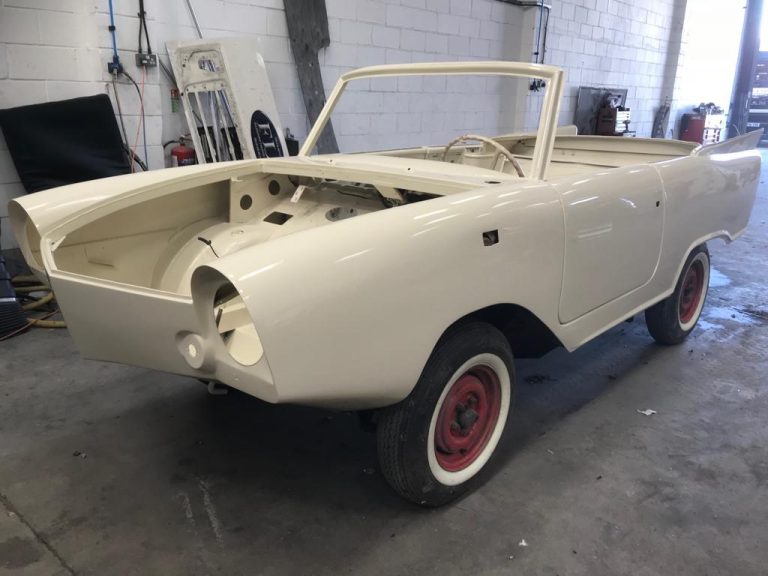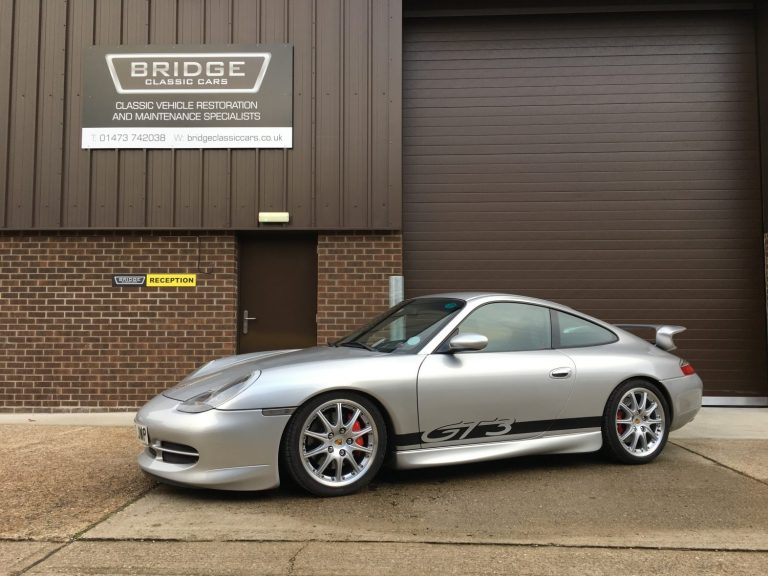
The wait is over…
Our 1965 Amphicar is now ready to leave the paintshops and return for refit. The red colour has disappeared to be replaced by the original Beach


Our 1965 Amphicar is now ready to leave the paintshops and return for refit. The red colour has disappeared to be replaced by the original Beach

Today we had a visit from one of the members of the Region 12 Porsche Club GB with his beautiful 2000 Porsche GT3. Source: Wikipedia

The underside of our 1985 Mercedes 280SL has now been successfully stripped down, cleaned up and under sealed. Just in time for the new exhaust
Our 1965 Amphicar is now ready to leave the paintshops and return for refit.
The red colour has disappeared to be replaced by the original Beach Strand White finish – Ditzler Code 8703=DAR offset 90113. Supplied by PPG Industries who bought out Ditzler.
The car will be returned to the original specification and will be restored to concours condition to include all UK paperwork required for use both on the road and water.
Today we had a visit from one of the members of the Region 12 Porsche Club GB with his beautiful 2000 Porsche GT3.
The “GT3” nameplate was introduced in 1999 as part of the first generation of the Porsche 996 model range (commonly known as 996.1). As with Porsche’s previous 911 RS models, the 996 GT3 was focused on racing, and so was devoid of items that added unnecessary weight to the car. Sound deadening was almost completely removed, as were the rear seats, rear loud speakers, sunroof, and air conditioning, although automatic air conditioning and CD/radio became no-cost optional add-ons.
The engine of the 996 GT3 set it apart from most of the other Porsche 996 models, although it shared the same basic design of the standard so-called “integrated dry sump” flat-six engine. The engine is naturally aspiratedand based on the unit used in the Porsche 962 and Porsche 911 GT1 race cars. That engine was known as the ‘Mezger’ engine, after its designer Hans Mezger. The engine uses the original air-cooled 911’s versatile dry-sump crankcase, with an external oil reservoir. The 996 GT3 has 360 PS (265 kW; 355 hp), compared to the 300 PS (221 kW; 296 hp) of the regular Porsche 996. In GT3 configuration, this so-called “split” crankcase(meaning the parting line of crankcase is on the crankshaft centreline) uses, instead of a fan and finned cylinders, separate water jackets added onto each side of the crankcase to cool banks of three cylinders with water pumped through a radiator. Thus, the GT3 engine is very similar to the completely water-cooled Porsche 962 racing car’s engine, which is based on the same crankcase. The 962 differs, however, by using six individual cylinder heads while the GT1/GT3, like the air and water-cooled Porsche 959, uses two cylinder heads, each covering a bank of three cylinders. The GT3 engine could thus also be thought of as similar to a 959 engine, but with water-cooled cylinders. Up to early model year 2004 996 GT3 production, the basic casting used for the crankcase of the GT3 was the same as the air-cooled engine. The “964” casting number was visible on the bottom of the crankcase, and on areas normally machined in air-cooled applications, but not in water-cooled ones. The crankcase casting was changed in mid-2004 to a “996” casting number crankcase to eliminate these external air-cooled remnants, but internally it was the same.
Because the 911 air-cooled crankcase uses the Porsche 356 engine to transmission mounting flange configuration, the 996 GT3 used a manual gearbox also of air-cooled 911 heritage. This gearbox has interchangeable gear ratios and is more durable making it more suitable for racing than the standard 911 type 996 gearbox.
To bring the vehicle’s track-prowess to the maximum level, Porsche endowed the GT3 with enlarged brakes, a lowered, re-tuned suspension system, lighter-weight wheels and a new front bumper with matched rear spoiler to help increase downforce, thereby increasing grip.
Porsche offered a no-cost option for the GT3 called the ‘Clubsport’ package. This option replaced the standard electrically adjustable leather front seats with manually adjustable racing buckets finished in fire-retardant fabric, single mass flywheel, bolt-in half-roll cage, 6-point drivers racing harness (also replacing the standard side airbags), fire extinguisher (mounted in the front passenger footwell) and preparation for a battery master switch. The Clubsport option was never offered to US customers, ostensibly due to the additional DOT crash testing that would have been required to allow US sales.
The underside of our 1985 Mercedes 280SL has now been successfully stripped down, cleaned up and under sealed.
Just in time for the new exhaust system to be fitted.
And thank you to William for spotting the exhaust rubbers pulling the rear pipes slightly to the left. A new set of rubbers and now the exhaust is sitting in position correctly.
Bridge Classic Cars are award winning Classic Car Restoration and Maintenance specialists. Your pride and joy is in safe hands with our expert Classic Car Technicians. Take a look at our awards here.